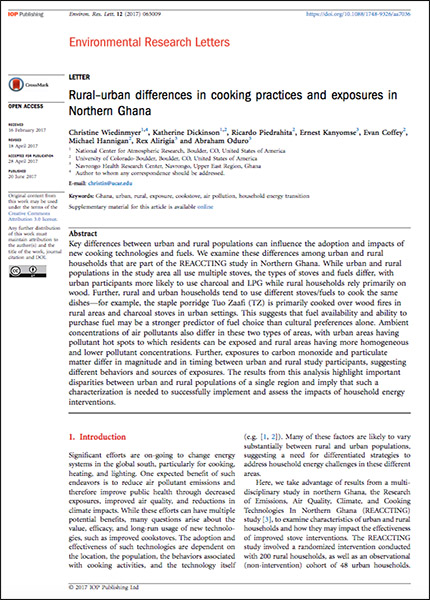 Rural–Urban Differences in Cooking Practices and Exposures in Northern Ghana Rural–Urban Differences in Cooking Practices and Exposures in Northern Ghana
by C. Wiedinmyer, K. Dickinson, R. Piedrahita, E. Kanyomse, E. Coffey, M. Hannigan, R. Alirigia, and A. Oduro
Environmental Research Letters 12 (6), doi: 10.1088/1748-9326/aa7036 (2017)
Abstract: Key differences between urban and rural populations can influence the adoption and impacts of new cooking technologies and fuels. We examine these differences among urban and rural households that are part of the REACCTING study in Northern Ghana. While urban and rural populations in the study area all use multiple stoves, the types of stoves and fuels differ, with urban participants more likely to use charcoal and LPG while rural households rely primarily on wood. Further, rural and urban households tend to use different stoves/fuels to cook the same dishes—for example, the staple porridge Tuo Zaafi (TZ) is primarily cooked over wood fires in rural areas and charcoal stoves in urban settings. This suggests that fuel availability and ability to purchase fuel may be a stronger predictor of fuel choice than cultural preferences alone. Ambient concentrations of air pollutants also differ in these two types of areas, with urban areas having pollutant hot spots to which residents can be exposed and rural areas having more homogeneous and lower pollutant concentrations. Further, exposures to carbon monoxide and particulate matter differ in magnitude and in timing between urban and rural study participants, suggesting different behaviors and sources of exposures. The results from this analysis highlight important disparities between urban and rural populations of a single region and imply that such a characterization is needed to successfully implement and assess the impacts of household energy interventions. Read more ... |
 Environment and the Media Environment and the Media
by G. Luedecke and M. T. Boykoff
The International Encyclopedia of Geography, Ed. D. Richardson, N. Castree, M. F. Goodchild, A. Kobayashi, W. Liu, and R. A. Marston, John Wiley & Sons, Ltd. (2017)
Excerpt: Media range from entertainment to news media, spanning traditional or mass media such as television, films, books, flyers, newspapers, magazines, and radio, as well as new media such as the Internet in general, Web 2.0, and social media. Traditional media rely on one-to-many (often monodirectional) communications and are sometimes referred to as “mass media,” whereas new or social media involve many-to-many, more interactive, webs of communications. Since the 1990s, the shift from traditional to new media has signaled substantive changes in how people access and interact with information, who has access to it, and who are considered “authorized” definers (e.g., actors with more power and influence than others) of the various dimensions of environmental issues. It is argued that new and social media have democratizing influences, as these channels of communication often offer a platform for more people to become content producers, and therefore have the potential to more readily shape the public agenda. Read more ... |
